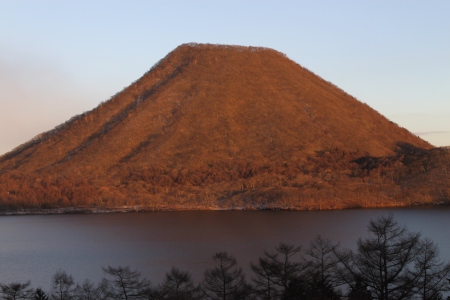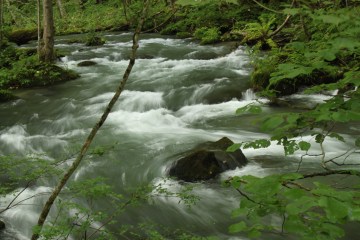Mention Mt. Ōe to any Japanese person, and they’ll likely start indulging you in the legends of the many oni (demons) that roam the ridges of the hallowed peak. Despite the less than stellar image, a traverse along the entire mountain range in good weather is one of the best hikes in Kansai for panoramic views.

The hike: There’s a water source at the shrine so fill up your bottles before setting out and take a couple of minutes to admire the wonderful view of the valley below. The trail starts just to the left of this water fountain (on the right side of the road), but if you look across the road you’ll see a trail marked for the Oni’s cave (鬼の洞窟). You could consider taking this 10-minute detour to check out the cave (I didn’t have time when I went so I’d be curious to know what’s down there). Anyway, take the trail marked for Senjogatake (千丈ヶ嶽) which meanders through a beautiful forest on a series of wooden steps built into the hillside. It’s a steep climb at first but the grade flattens out a bit as you approach the ridge. After about 15-minutes you’ll reach a trail junction where you’ll turn right for the final climb up to the first of three summits. Shortly before the junction you’ll see a clearing on your left that has good views of the surrounding mountains. Continue the gentle ascent for another 10 minutes until arriving on a broad summit plateau. This is the official high point of Mt. Ōe, so pat yourself on the back and take a few minutes to take in the superb scenery. On a clear day you can see every mountain in Kyoto Prefecture as well as most of the peaks of Hyogo Prefecture. If the cloud is in (as it often is) then you’ll just have to use your imagination. The trail continues on the far side of the summit, so walk past the tall signpost and drop into the forest to the northwest. You’ll soon see signposts indicating a 500 meter horizontal distance to Hatogamine (鳩ヶ峰). Once you bottom out it’s a short but somewhat steep climb above the trees again to the top of the second peak, where there are even better panoramic views. This time you’ll be able to see the Sea of Japan and also see a mountain in front of your that resembles an inverted cooking pot. This is the final peak in the Ōe trilogy, aptly named Nabezuka (鍋塚 – Nabe pot mound). It’ll take about an hour to reach the summit of that mountain, so continue traversing along the trail directly in front of you. Again you’ll drop back down into the forest and descend to a saddle, where you’ll find a parking lot and toilet. This is an escape route if you don’t have the time or energy for the final peak. All you need to do is follow the forest road back down into the valley and you’ll arrive at the bus stop. Otherwise, continue on the trail just above the parking lot. It’s a long, gentle climb with views that open up the higher you go. After about 15 minutes you’ll reach a junction with a path shooting off to the right. The signpost is hand-written and hard to read, but this is the trail you want to take on the way down after visiting the summit of Nabezuka. It’s 500 horizontal meters to the top and it should take you about 10 minutes to reach it. There are a couple of benches you can use to take a rest and admire the scenery. Once satisfied, retrace your steps back to the junction and turn left, dropping through an area of ankle-turning rocks before reaching a forest road with a signpost that says Oeyama Green Lodge 3.5km. Turn left and walk on the flat gravel road, following the signs to the lodge as you wind your way though an area with blue netting set up to keep the deer from eating the tree bark. At the end of the road the trail will fork to the left, so follow the steep switchbacks for about 20 minutes until reaching a paved road. Walk down the road and turn left when you see the signpost that reads Viewpoint of the Senjougataki 150m. If you have extra time you could walk that extra 150 meters to see the waterfall, but keep the (limited) bus times in mind. From here it’s about a brisk 10-minute walk to the bus stop. Turn left when the road merges with the main road (there are a couple of colorful Oni statues here). The bus stop is just down from the entrance to the Oni museum, which makes for a great place to kill time if you’re stuck waiting for the 6:10pm bus.
When to go: This hike is best done from mid-April to late November, when the trails are clear from snow. The peak is also popular for snowshoeing from the ski resort, but you will need a lot of stamina and time to traverse all the way over to the high point.
Access: Although best approached by car, relying on public transport, though inconvenient, allows you a chance to traverse the entire ridge without having to retrace your steps back to the car. From either Osaka or Kyoto, take a JR train to Fukuchiyama (福知山) station and change to a local train bound for Miyazu (宮津) on the Kita Kinki Tango Railway (北近畿タンゴ鉄道). Get off at Ōeyamaguchi-Naiku (大江山口内宮) station. The railway platform is actually inside of the JR station, so go downstairs and then up to the second floor and buy a separate ticket there. It costs 380 yen one-way from Fukuchiyama station. You might find it faster to take a limited express JR train to Fukuchiyama if you don’t want to leave at the crack of dawn. The first limited express train leaves Kyoto at 9:25am (9:10am from Osaka) on weekends, which allows you plenty of time to connect to the 11:07am train bound for Miyazu. That’ll get you to Ōeyamaguchi-Naiku at 11:36am. Go out the exit, down the stairs, and turn left on the main road when you get outside. Walk 100 meters down the road to the Tourist Information Center, marked by the colorful oni statue outside. The staff there will call a taxi for you (tell them you want to go to Oni-take Inari Jinja (鬼岳稲荷神社). The local taxi company is now bankrupt, so you’ll need to wait about 30 minutes for the taxi to come from Fukuchiyama to fetch you. The taxi will cost about 2500 yen for the 15-minute journey to the trailhead.
From the end of the hike at Ōeyama-no-ie, there is a cheap bus back to Ōe station, where you can take the train back to Fukuchiyama and transfer back to a JR train for Kyoto or Osaka. There are only 2 buses in the afternoon, so aim for the 3:50pm bus if you’re a fast hiker or the more leisurely 6:10pm bus. There’s a great museum at the bus stop dedicated to the Oni culture if you’ve got extra time to kill before the bus. The bus, if you can call it that, is nothing more than a minivan that seats 7 people. It only costs 200 yen to ride and the driver is friendly. Click here for the bus schedule.
Map: Click here
Level of difficulty: 2 out of 5 (elevation change ~200 meters)
Total Round-trip Distance: 10km (4 to 6 hours)










